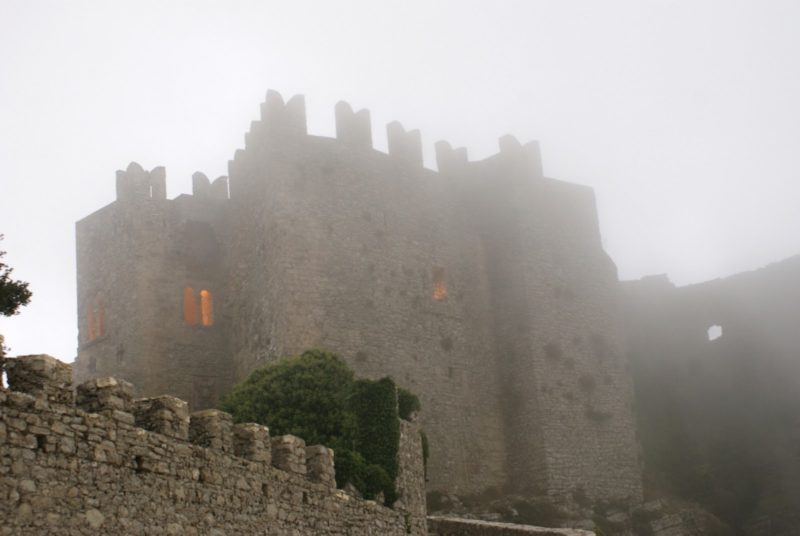The Places of the Myth of Venus in the regional map of places and identity and memory.
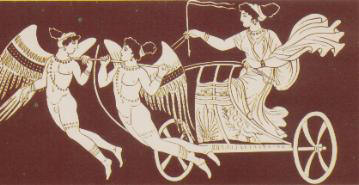
Aphrodite on a chariot pulled on a chariot
Origin of the Myth
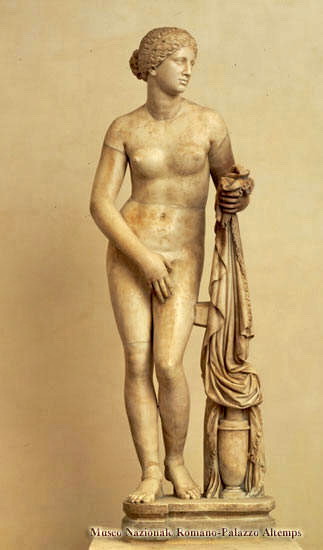 In Greek mythology she is the goddess of love and her cult spread not only in Greece but also in the West, where she was identified with the Italian Venus. According to Homer, she was the daughter of Zeus need Dione, although, according to another narration, probably more ancient, Aphrodite was born from the blood leaking from the sexual organs of Uranus, which were cut by Cronos at the instigation of his mother Gaia. The blood, falling from the sky, mixed with the waves of the sea, thus generating Aphrodite the "woman born of the waves".
In Greek mythology she is the goddess of love and her cult spread not only in Greece but also in the West, where she was identified with the Italian Venus. According to Homer, she was the daughter of Zeus need Dione, although, according to another narration, probably more ancient, Aphrodite was born from the blood leaking from the sexual organs of Uranus, which were cut by Cronos at the instigation of his mother Gaia. The blood, falling from the sky, mixed with the waves of the sea, thus generating Aphrodite the "woman born of the waves".
The origin of the cult is perhaps Phoenician-Babylonian and the oldest sanctuary dedicated to Aphrodite was, according to Erotodus, that of Ashkelon, in Phenicia. It is probable that, in its initial form, the cult of the Asian goddess was linked to aspects of fertility and generation (as the cults of isthar in Babylon and Astarte in Phenicia), but the Greek Aphrodite assumed exquisitely Hellenic characteristics.
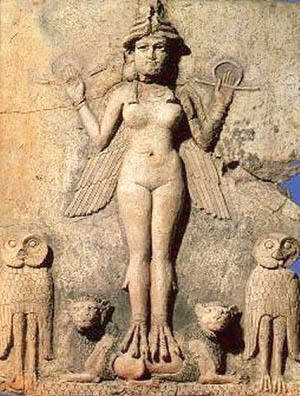
Ancient representation of Ishtar
Having been born from the sea, Aphrodite is not only the goddess of love but is also revered by sailors for her ability to make navigation beautiful and safe. Moreover, it is she who also makes the earth beautiful by being the goddess of spring in bloom.
Her favorite plants are the rose, the pomegranate and the myrtle and, among the animals, the dove is dear to her.
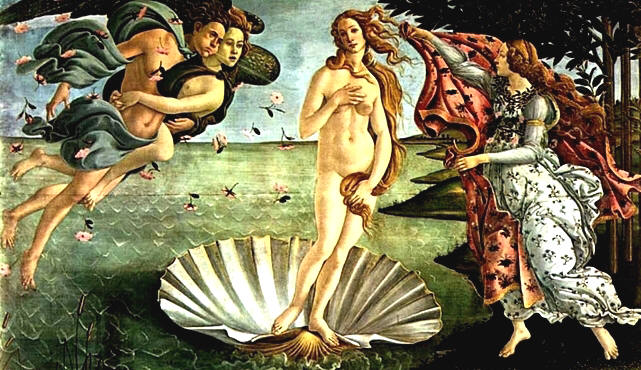 Birth of Venus (Botticelli ca. 1482)
Birth of Venus (Botticelli ca. 1482)
Aphrodite is represented with her body decorated with roses and myrtles, on a chariot pulled by sparrows, doves and swans. It personifies beauty, and when the Discord cast a Paride the apple destined to belong to the most beautiful of the Olympian goddesses, Paris chose Aphrodite, discarding Hera and Athena.
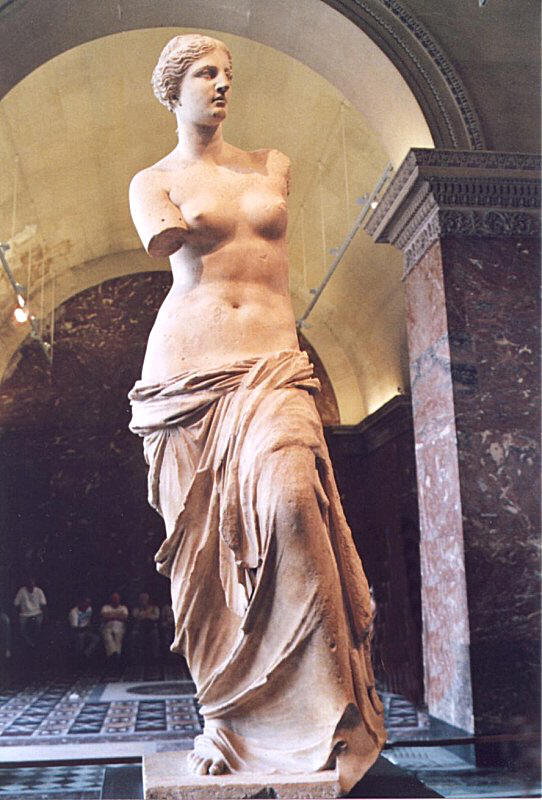 Venus de Milo (Louvre)
Venus de Milo (Louvre)
The Myth in Sicily
In the West the cult of Aphrodite spread more in Sicily, on the mountain Erice (today S. Giuliano), where, probably, there was a Punic sanctuary dedicated to the goddess Tanit [1]. From Sicily the cult spread to Italy up to Rome where it was venerated with the name of Venus Ericina. Diodorus Siculus (lib IV.83) gives his version of the reason for the nickname “Ericina”: Erice was the son of Aphrodite and Buta, the local king of Sicily. He, in turn, became king, founded a city that took his name, placed it on a rock and, at the highest point, built a sanctuary dedicated to his mother. The goddess showed particular affection for the city of Erice and for this she was called Aphrodite Ericina.
The importance of the cult of Venus Ericina is also evidenced by the discovery of a republican coin of 57 BC, where the temple of Erice is depicted on top of a rock surrounded by turreted walls [2].
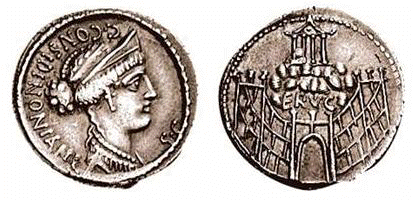
Roman coin of 57 BC with Venus Ericina
The Roman Senate decreed that seventeen Sicilian cities, among the most faithful to Rome, pay tribute in gold to the sanctuary of Venus Ericina, to which two hundred guard soldiers were also assigned.
The slaves assigned to the Sanctuary of Venus Ericina were used by the Roman governor Verre as subordinates, some used as tithe collectors and, often, also to steal, secretly or by force, the works of art on which Verre had placed the eyes.
More than one element would suggest the oriental influence in the cult of Aphrodite Ericina: it was particularly flourishing in the regions originally inhabited by the Elimi, in which the influence of the Phoenician-Punic culture was considerable. Another element is given by the fact that in Erice the goddess was considered, as in ancient times, the protector of fertility, and always in Erice the cult of sacred prostitution was exercised.This cult was practiced by the priestesses of the Assyrian-Babylonian goddess Istar, divinity of love and fecundity, which probably descended from the Sumerian goddess of love, Innana. Another element that would seem to bind the two deities is the dove that probably derives from the cult of Istar, in fact in Greek dove is said "will perish ", or bird of Istar. Prostitution of priestesses was widespread among the Punics. There is talk of a sanctuary dedicated to Venus, in Sicca Veneria, on the African coast (now El Kef in Tunisia), where the prostitution of girls employed in the care of the temple was widespread [3]. To be honest, we must also remember that the phenomenon of prostitution of priestesses also existed in the temples of Aphrodite of Locri and Corinth [4], where the cult had taken on more exquisitely Hellenic characteristics.
To explain the origin of this form of prostitution, one could think of the same mechanism that led, for example, the Indian Sioux hunters to feed on the still warm heart of the killed bison: this created a close spiritual bond between the hunters and the bison, animal from which they got their sustenance. This link would also have favored the discovery of hunting trails. In sacred prostitution, on the other hand, one might think that the union with one of the goddess's priestesses idealized a spiritual union with the divinity. Nothing prevents us from thinking that this habit was also due to a much less spiritual need, and more linked to the physiological needs of sailors. In fact, this form of prostitution existed in the temples of Locri, Corinto, Sicca Veneria and in other seaside villages that hosted temples dedicated to Venus, where the sailors, returning from long periods of navigation, went ashore and made, in their own way, honor to the goddess of love.
Another element that could, although not necessarily, suggest oriental influence, would be the presence, on some coins, of the figure of the dog close to that of the goddess. The dog often appears in oriental mythology, in fact, to the Persian goddess Tanit dogs were sacrificed [5]. But the dog in Sicilian mythology has been an almost constant presence, associated with many divinities, even those who have not suffered any oriental influence.
In reality, the elements cited above are not sufficient to be able to affirm with certainty that the cult of Aphrodite Ericina is of oriental origin and that it subsequently underwent a form of Hellenization, as happened for most indigenous cults. The opposite could have happened, namely that the cult, in its Hellenic form, underwent, for religious and / or political reasons, a transformation by the Punics.
That there was an attempt to unite the cult of Aphrodite Ericina with the territory of Carthage, an ancient ceremony would demonstrate [6]: once a year, traveling pigeons departed from the temple of Erice towards Carthage, only to return after a few days , welcomed by the cheering population who considered them companions of the goddess who, invisible, visited the African place and then returned to the temple. Emanuele Ciaceri affirmed that, in his time, at the end of the 800th century, it was still possible to observe doves that, annually, departed from Mount Erice to go to Libya and then return [7].
Beyond the origin of the cult, in the Elymian region and in any case in the whole area under Punic influence, Aphrodite was seen as the goddess of fertilization, as well as the protector of sailors. With characteristics more in keeping with classical Hellenic mythology, the cult of Aphrodite was practiced in the rest of the island. There is talk of this cult a SIRACUSA, Acre, Messina, Selinunte, Hymera, Naxos e Catania [8].
The archaeological findings provide information on the cult of Aphrodite in different parts of Sicily; on the Mount Iato, seat of the ancient Elimo center of Iaitai, the remains of a sanctuary dedicated to the goddess have been found. Under the remains of the sanctuary, dating back to the mid-sixth century. BC [9], traces of occupation dating back to the end of the eighth century BC have been found. This would suggest a later Hellenized indigenous cult.
Of the three temples of Selinunte designated with the letters E, F, and G, temple E which is normally attributed to Hera, is also assigned to Aphrodite [10].
Also to Morgantina traces of the cult of Aphrodite have been found. In addition to an ancient inscription that would suggest the existence of a temple dedicated to the goddess, the remains of a sanctuary were found and, in the vicinity, a vase dedicated to Aphrodite. The sanctuary can be traced back to the end of the XNUMXth century. B.C.
Ad Akray, the remains of a sanctuary of the sixth century are still visible. B.C; an inscription dedicated to Aphrodite would suggest that it too was dedicated to the goddess [11].
Ad Hymera, one of the temples in the sacred area of the upper city, and precisely the one named with the letter B, is perhaps attributable to Aphrodite [12].
Finally, also one of the sanctuaries found in Megara Iblea it is attributed to the cult of the goddess.
Religious syncretism
With the arrival of the Christian religion on the island, the influence of the cult of Aphrodite was not completely exhausted. On Mount Erice, seat of the ancient temple of Venus Ericina, a temple was erected Virgin Mary, but the nickname "the beauty of the seven veils”Is a clear link to the ancient pagan cult. Even in the XNUMXth century, during the celebrations of the Madonna, the population visited the pagan temple frequently. This forced the members of the clergy to take measures to discourage this habit, increasing the solemnities of the feast of the Madonna and granting particular indulgence to the participants.
The abandonment of the cult of Aphrodite could be, in some way, related to the popular belief about the existence of ghost of Bellina in the territory of Monte Erice: according to this belief a woman, who initially appears from a window in the form of a beautiful girl, slowly turns into a snake [13]. The Sicilian popular tradition could be placed in the same perspective according to which in Monte S. Giuliano, as Monte Erice is now called, there are the most beautiful women in Sicily; but if these come down from the mountain to settle elsewhere, they lose all their beauty [14].
Erice
An ancient Sicilian proverb also says:
Cu sali vaja flights to Trapani
Cu beddi vaja flights to lu Munti.
The transition from the pagan cult of Venus Ericina to that of the Madonna was not, therefore, immediate and the reluctance on the part of the population to abandon a form of cult rooted for centuries, meant that the religious ceremonies in honor of the Madonna, concealed residues of the ancient pagan cult. An example was the feast of the Madonna of Custonaci, in the town of Monte San Giuliano, during which a parade was held astride a series of characters representing Venus, Mars, Mercury, Saturn. The explanation of this parade was the following: the pagan deities had been sent by the same God, as demons of evil to punish the city for its sins and the Madonna of Custonaci, to save the city [15], had to stop the same hand divine.
It cannot be excluded that also in other parts of Sicily the pagan cult of Aphrodite was mixed with that of some Christian saint, as perhaps happened for St. Venera, in Avola and Acireale, or for the "Madonna of the mortella”Of Villafranca which recalls the myrtle, one of Aphrodite's favorite plants [16].
The Places of the Myth of Venus has been included in the Regional Charter of Places and Identity and Memory (Places of Myth and Legends). Even if the recognition of the Sicilian Region is limited only to the places of Syracuse and the Aeolian Islands
Places indicated in the IWB register of the Sicily Region (Places of Identity and Memory):
- Mirror of Venus (Pantelleria)
- Temple of Venus Ericina (Erice)
Note:
The reasons why the Pantelleria Lake known as the Mirror of Venus was included, where the landscape overlooking it, of undoubted beauty, is reflected on the water so much that it is called the Mirror of Venus.
Taken from: Cults Myths and Legends of Ancient Sicily by Ignazio Caloggero
Find out more on: Sicilian Intangible Heritage database
Interactive databases of Sicilian Cultural Heritage: Data Maps Heritage Sicily
[1] Tanit is the Carthaginian version of Phoenician Astarte, wife of Baal, goddess of love and mistress of Carthage.
[2] F. Coarelli and M. Torelli: Sicily “Archaeological Guides Laterza” p.57.
[3] Ciaceri Emanuele: Cults and Myths of Ancient Sicily p.83.
[4] In Corinth there were more than a thousand sacred prostitutes and, according to the historian Strabo, constituted the main attraction of the city.
[5] Ciaceri Emanuele: Cults and Myths of Ancient Sicily p.122
[6] Ettore Pais: History of Ancient Italy p.45 Vol. II.
[7] Ciaceri Emanuele: Cults and Myths of Ancient Sicily p. 84
[8] Ciaceri Emanuele: Cults and Myths of Ancient Sicily p. 179
[9] F. Coarelli and M. Torelli: Sicily “Archaeological Guides Laterza” p.47.
[10] Filippo Coarelli and Mario Torelli: Sicily “Archaeological Guides Laterza” p.84.
[11] Filippo Coarelli and Mario Torelli: Sicily “Archaeological Guides Laterza” p.294.
[12] Filippo Coarelli and Mario Torelli: Sicily “Archaeological Guides Laterza” p.403.
[13] Giuseppe Pitrè Uses and Customs Beliefs and prejudices of the Sicilian people p.43
[14] Giuseppe Pitrè Uses and Customs, beliefs and prejudices of the Sicilian people. Vol IV. p. 479.
[15] Giuseppe Pitre: Patronal Festivals In Sicily p. 475.
[16] Giuseppe Pitre: Patronal Festivals In Sicily p. 406.
_-_The_Birth_of_Venus_(1879).jpg) Birth of Venus (Musée d'Orsay Paris -Bouguereau 1879)
Birth of Venus (Musée d'Orsay Paris -Bouguereau 1879)
Ignazio Caloggero


